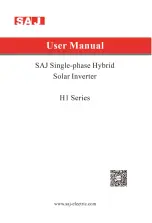
10,000 Watt AC Inverter by Wagan Tech
Thank you for purchasing this DC to AC power inverter by Wagan Tech. With minimal care
and proper treatment it will provide years of reliable service. Carefully read, understand and
comply with all instructions before use. Keep this manual for future reference.
AboUT These InverTers
This heavy-duty power inverter converts 2 volt direct current (2V DC) to 5 volt
alternating household current (5V AC). It easily powers large TV/VCR combinations,
microwave ovens, refrigerators, and room air conditioners. It also operates at up to 90%
efficiency, which results in longer running time and extended battery life compared to other
inverters at this level of power.
This inverter has the highest surge capability in it’s class. Superior surge capability allows
this inverter to start the most difficult motorized loads. Advanced circuitry runs cooler and is
more reliable than competing units.
General Instructions:
Keep your Inverter dry and away from any direct heat source or combustible
materials or gases.
Keep well ventilated—this device generates heat.
Do not continuously operate your inverter at more than its rated output wattage.
Your inverter will only operate from a 2 volt DC battery.
Reversed DC polarity will damage the inverter and void the warranty.
Do not connect the inverter to any other power source, including any AC power
source. These actions will damage this inverter.
There are no user serviceable parts inside this inverter
LoAd ConsIderATIons
As an appliance motor starts, it requires a momentary surge of power called “starting load”
or “peak load”. Once started, that appliance needs less power to operate. This is called the
“continuous load”. It is important to know starting loads and continuous loads of appliances
that are to be powered by this inverter.
Appliance power is rated in watts. This information is usually stamped or printed on most AC
appliances and equipment. In some cases, a tool will be rated in amperes. To convert amps
to watts, multiply: AMPS × 5 (AC voltage) = WATTS. This formula yields an approximation
of the continuous wattage load of that appliance.
The starting load of an appliance is a major factor of whether an inverter can power it.
Starting load is momentary. With many appliances, it is approximately twice the continuous
load. However, some appliance starting loads can be as high as eight times the continuous
load. To determine if an appliance or tool will operate with this inverter, run a test. This
inverter is will automatically shut down in the event of an overload, so there is no danger of
damaging either the inverter or the equipment.
•
•
•
•
•
•
•
R
www.wagan.com



































